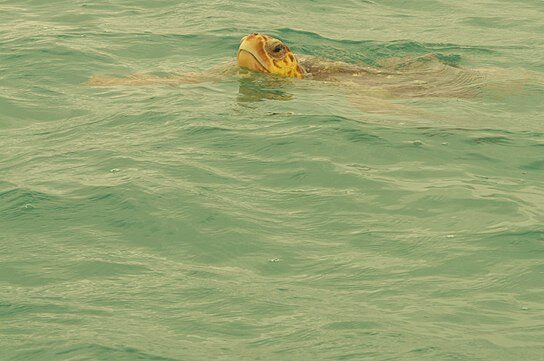
New research indicates that the Earth’s oceans are undergoing a notable transformation in colour, a phenomenon likely attributed to the escalating impacts of climate breakdown.
Contrary to its familiar deep blue hue, the ocean is progressively adopting a greener tint, with regions near the equator experiencing more pronounced shifts.
“The reason we care about this is not because we care about the colour, but because the colour is a reflection of the changes in the state of the ecosystem,” said BB Cael, a scientist at the National Oceanography Centre in Southampton and author of the study published in Nature.
While previous investigations primarily centred on assessing variations in oceanic greenness derived from chlorophyll in plankton, the study led by Cael and his team delved into a comprehensive analysis of two decades’ worth of observations from NASA’s Modis-Aqua satellite. By scrutinising changes in the ocean’s colour spectrum, encompassing a broader range of hues including red and blue, the researchers unveiled patterns indicating evolving plankton populations worldwide.
Plankton of diverse sizes interact with light in distinctive ways, influenced by their pigments and characteristics. This exploration into shifts in coloration offers researchers enhanced insight into the dynamic transformations occurring within ocean ecosystems. Phytoplankton, constituting the foundation of numerous marine food chains, underscores the pivotal role they play in maintaining oceanic balance.
The analysis contrasted these alterations in colour with predictions drawn from a computer model simulating an alternate reality where human-induced global warming had not occurred. The divergence between observed changes and these simulated scenarios highlighted a clear connection between the ocean’s shifting colour palette and anthropogenic climate change.
The ramifications of this evolving phenomenon extend across a vast expanse, impacting 56% of the world’s oceans – an area surpassing the entirety of Earth’s landmass.
“We do have changes in the colour that are significantly emerging in almost all of the ocean of the tropics or subtropics,” said Cael.
While a prevailing “greening effect” is evident in most regions, instances of rising or diminishing red and blue hues have also been observed, indicating a more intricate transformation process.
“These are not ultra, massive ecosystem-destroying changes, they may be subtle,” said Cael. “But this gives us an additional piece of evidence that human activity is likely affecting large parts of the global biosphere in a way that we haven’t been able to understand.”
While the discovery serves as a tangible testament to the consequences of climate change, the underlying mechanics and intensity of these changes remain enigmatic. Michael J Behrenfeld, an ocean productivity researcher at Oregon State University who was not involved in the study, underscores the need to unravel the underlying mechanisms behind this phenomenon and its implications for oceanic dynamics.
“Most likely, the measured trends are associated with multiple factors changing in parallel,” said Behrenfeld. For instance, the potentially increasing abundance of microplastics in the ocean, which like any other particles increase light scattering.
“With answers to these questions, we can then begin understanding what the ecological and biogeochemical implications are,” said Behrenfeld.
NASA is poised to launch the Pace (plankton, aerosol, cloud, ocean ecosystem) satellite mission in January 2024, a pioneering endeavour that will expand the scope of oceanic analysis. By measuring hundreds of colours within the ocean instead of a limited selection, the Pace mission will catalyse further exploration into these intricate shifts, propelling our understanding of the evolving marine ecosystems and the interplay between climate change and oceanic dynamics.
“Making more meaningful inferences about what the changes actually are ecologically is definitely a big next step,” said Cael.
——————————————————————————
At Natural World Fund, we are passionate about stopping the decline in our wildlife.
The decline in our wildlife is shocking and frightening. Without much more support, many of the animals we know and love will continue in their decline towards extinction.
When you help to restore a patch of degraded land through rewilding to forests, meadows, or wetlands, you have a massive impact on the biodiversity at a local level. You give animals a home and food that they otherwise would not have had, and it has a positive snowball effect on the food chain.
We are convinced that this is much better for the UK than growing lots of fast-growing coniferous trees, solely to remove carbon, that don’t actually help our animals to thrive.
This is why we stand for restoring nature in the UK through responsible rewilding. For us, it is the right thing to do. Let’s do what’s right for nature!
Donate today at https://naturalworldfund.com/ and join in the solution!

